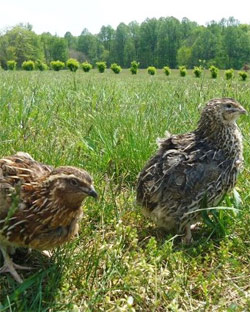 A study has inferred that on studying ‘quail’ sexual behaviour Japanese researchers are trying to understand human sexuality. Japanese researchers are studying quail to understand the underlying mechanisms involved in their breeding behaviours. At Nagoya University and the National Institute of Basic Biology, researchers have found a brain receptor that helps to initiate quail breeding. Meanwhile, researchers at Waseda and Kitasato universities are exploring the neurochemical link between male aggressiveness and the presence of females.
A study has inferred that on studying ‘quail’ sexual behaviour Japanese researchers are trying to understand human sexuality. Japanese researchers are studying quail to understand the underlying mechanisms involved in their breeding behaviours. At Nagoya University and the National Institute of Basic Biology, researchers have found a brain receptor that helps to initiate quail breeding. Meanwhile, researchers at Waseda and Kitasato universities are exploring the neurochemical link between male aggressiveness and the presence of females.
The Japanese quail is commonly used to study socio-sexual behaviours and their underlying mechanisms. Quail undergo rapid and robust sexual changes during their short breeding season, which happens in response to seasonal changes. Sexually mature male quail are also known to fight with intense aggressiveness, yet this aggression seems to decrease in the presence of female quail.
Deep brain photoreceptor
Meanwhile, at Waseda and Kitasato universities, scientists are studying the neurochemical pathways involved in translating social signals into physiological reproductive changes.
In 2000, researchers at Waseda University identified for the first time a new hormone, called gonadotropininhibitory hormone (GnIH), located in the brains of quail that inhibits reproduction. This hormone has also been identified in mammals. The researchers found that nerves related to this hormone also projected to areas of the brain related to aggressive and sexual behaviours. This led them to further explore how the hormone was linked to aggression in male quail.
In one study, published in Nature Communications, the researchers injected the hormone into a male’s brain. They found that this increased the activity of an enzyme called aromatase that converts the male hormone androgen into the female hormone oestrogen. Oestrogen levels in the brain thus greatly increased. Also, when they injected high concentrations of oestrogen into a male’s brain, its aggressive behaviour greatly decreased.
In a separate study, published in The Journal of Neuroscience, the researchers analysed how the presence of female quail modifies both the reproductive hormones in a sexually active male, and the synthesis and release of neurochemicals in its brain. They found that when a male quail sees a female quail, this causes a rapid increase in the release of GnIH, resulting in the suppression of pituitary gonadotropins that stimulate the secretion of testosterone. The female’s presence thus rapidly decreases testosterone levels in the male quail. This is exceptional within most vertebrate species in which increases in testosterone levels usually follow interaction with a female.
In 2015, the researchers plan to explore how the presence of female quail modifies neurosteroid levels in the male brain, and investigate why the presence of a female decreases aggression and plasma testosterone levels. Ultimately, they say, future work involving the study of socio-sexual behaviours in humans could lead to new ways to regulate aggressiveness.